The Intel Core i3-7350K (60W) Review: Almost a Core i7-2600K
by Ian Cutress on February 3, 2017 8:00 AM ESTTotal War: Attila
The Total War franchise moves on to Attila, another The Creative Assembly development, and is a stand-alone strategy title set in 395AD where the main story line lets the gamer take control of the leader of the Huns in order to conquer parts of the world. Graphically the game can render hundreds/thousands of units on screen at once, all with their individual actions and can put some of the big cards to task.
For low end graphics, we test at 720p with performance settings, recording the average frame rate. With mid and high range graphics, we test at 1080p with the quality setting. In both circumstances, unlimited video memory is enabled and the in-game scripted benchmark is used.
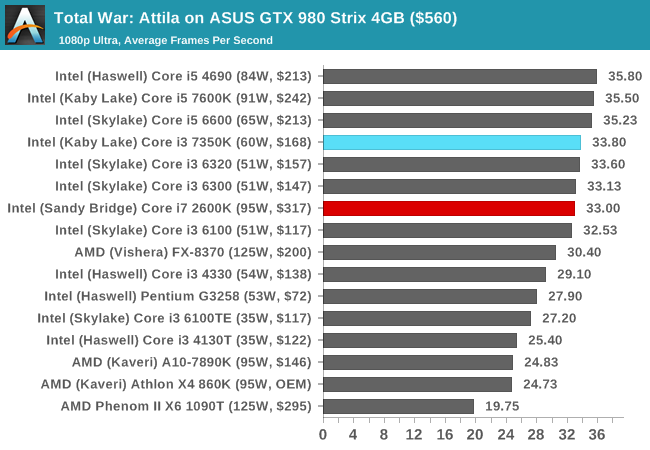
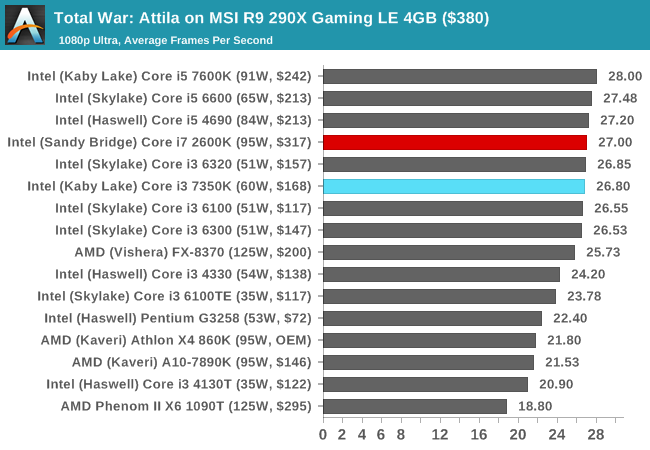
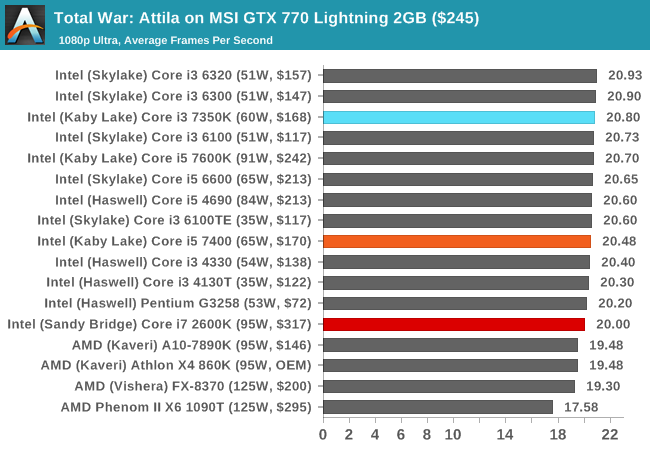
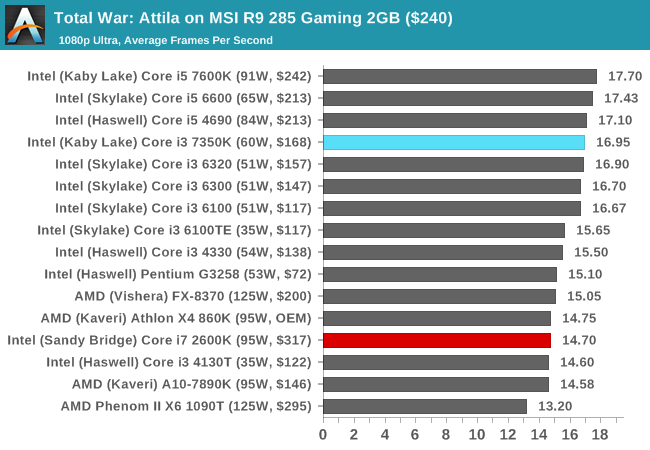
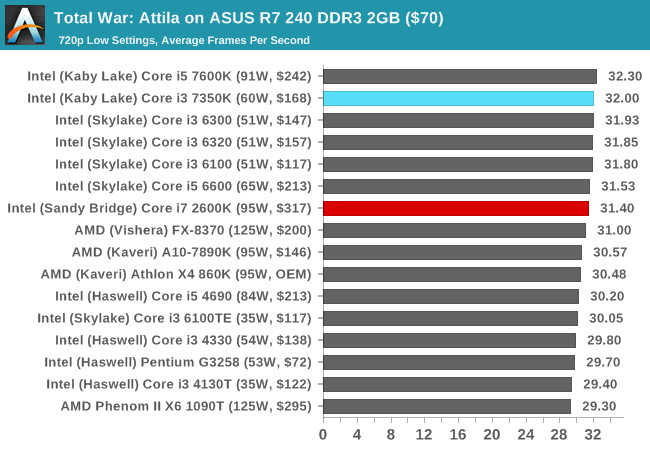
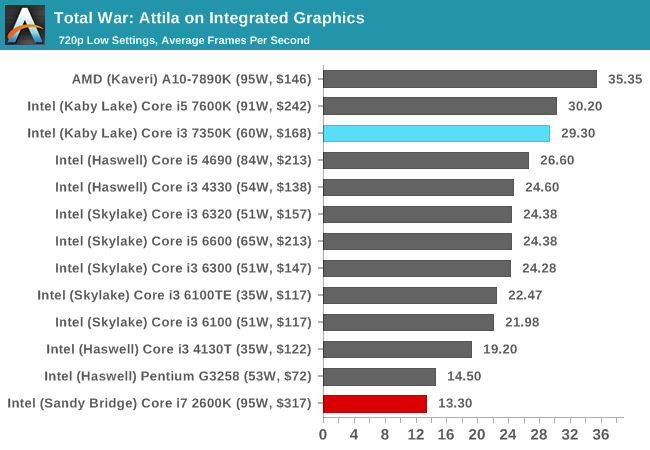
Similar to Alien Isolation, the only discrete GPU there seems to be much of a difference between the i3 and i7 is on the R9 285, where the newer microarchitecture has the advantage. The integrated graphics in Sandy Bridge were laughable, and the Core i3 offers over double the performance here.











186 Comments
View All Comments
Ian Cutress - Friday, February 3, 2017 - link
Next test bed update will be on W10. I keep getting mixed reactions recently from W10/W7/Linux users on this front - some want to see W10 poweeeeeer, others want default. But for DX12 it'll have to change over.CaedenV - Friday, February 3, 2017 - link
Bench-marking in win10 is... well... difficult. The OS has too many automatic features, so it is hard to get consistent results. You still get better overall performance... but not consistent performance. Win7 is gloriously dumb and gives very clear numbers to make very easy comparisons.Flunk - Friday, February 3, 2017 - link
It's a bit sad that you can compare any CPU from 2011 to one from 2017 and have them match up like this. In the 90's a CPU that was 6 years newer was many times faster than the older one. Is it lack of competition? Or have we just hit the wall with silicon chip technology?Ro_Ja - Friday, February 3, 2017 - link
Back in the days it was all about higher clock speed = faster. Nowadays it's a bit complex for me :\BrokenCrayons - Friday, February 3, 2017 - link
It's probably a combination of both, but I'd go out on a limb and say it's mostly due to technology and not so much market forces. Intel's primary competition for new processor models really ends up being its own prior generations It the company wants to land sales, it needs to offer a compelling incentive to upgrade.There's also Intel's efforts to reduce TDP over successive generations (something the company would probably not do were there more credible competitive forces in the market). Those reductions are probably a side effect of a mobile-first perspective in modern CPU design, but there's something nice about buying a reasonably power 35W desktop processor and not having to worry about copper-pipe festooned tower coolers with 120mm fans strapped on them just to keep your chip happy. If I were to build a new desktop, I'd entertain a T-series part before exploring any other option.
StrangerGuy - Friday, February 3, 2017 - link
It's funny we got big perf/watt increases over the past few years in CPUs and GPUs, yet somehow everyone are still buying massive overkill 650W+ PSUs where most systems would struggle to even draw 1/3 of the PSU rated wattage at load.I'm pretty confident that an undervolted i5 7400 and GTX 1060 (60W @ 1600MHz according to THG) would be able to draw <100W at the wall in a normal gaming load with an efficient enough PSU...
fanofanand - Friday, February 3, 2017 - link
Because MOAR POWER and marketing. Seriously, they sell the high power PSUs for a LOT more than the lower powered PSUs, it's going to take consumers buying the 300-450W psu's en masse before the manufacturers adjust. Your theoretical operates under false assumptions however. The 1060 boosts up well beyond 1600 and will consume far more than 60 watts, and there are efficiency losses in the PSU and throughout your system. Go ahead and try to run a 1060 and an undervolted i5, see what happens.t.s - Friday, February 3, 2017 - link
He said normal gaming. His number is quite possible --with good mobo, ssd, no optical drive.fanofanand - Friday, February 3, 2017 - link
No, it's not. For typical gaming the 1060 consumes between 90-120 watts. So please do tell me how his system with a 100 watt GPU is going to consume less than 100 watts with a CPU, mobo, RAM, etc.?hybrid2d4x4 - Friday, February 3, 2017 - link
As a point of reference, I have a 1060 in a i5 4670 system running a 400W Platinum PSU. All stock clocks, 1 SSD, 1 HDD. Peak power in games measured at the wall is ~200W (180-200 depending on which AAA game), so I doubt <100W is doable.But agree with the commentary about how overkill most PSUs are.